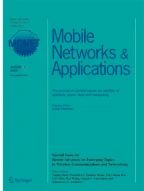Avoid common mistakes on your manuscript.
Editorial:
With the rapid development of mobile computing technologies, social computing emerges as a new computing paradigm that enables people to quickly and easily participate in social interactions, contribute their knowledge and share user-generated content, experiences and opinions. Social computing provides a wide platform where information flows elegantly according to people’s demands. Social computing is empowered by various technologies across different disciplines, such as crowdsourcing, collective intelligence, peer-to-peer computing, wireless access, device-to-device (D2D) communications and cloud computing, which jointly build a solid foundation to support social computing. On the one hand, these technologies evolve individually in their respective sectors to advance the development of social computing. On the other hand, they are also inversely affected by the requirements from social computing. The proliferation of social computing imposes many new challenges to these related areas. For example, the high distribution nature of social computing first requires a scalable and elastic infrastructure to meet both the communication and computation requirements. The social relationship inherent in social computing also has a deep impact on the computation, communication and storage resource management. Therefore, it is significant to jointly investigate social computing and its related disciplines to address these challenges for the progress of social computing.
This special issue features six selected high-quality papers covering a variety of aspects related to social computing, including service provision, resource allocation and management, network control, security and privacy issues.
The first article “Cost-Effective Service Provisioning for Hybrid Cloud Applications” identifies how to use hybrid cloud to provision social services in a cost-effective manner, with the consideration of load balancing, cloud computing platforms dynamics (e.g., breakdown or update) and price changes. The authors (Fangming Liu, Bin Luo and Yipei Niu) propose a Least Cost per Connection (LCC) algorithm to distribute job requests to the most cost-effective clouds while adapting changes among multiple public clouds. Compared with single cloud strategy, the proposed strategy decreases the cost and latency by 30.2 % and 10.1 %, respectively.
The second article titled “UFalloc: Towards Utility Max-min Fairness of Bandwidth Allocation for Applications in Datacenter Networks” by Fei Xu, Wangying Ye, Yuhan Liu and Wei Zhang then discusses bandwidth allocation for cloud applications in sharing datacenter networks. They notice that existing bandwidth allocation solutions may fail to guarantee the fairness of application performance (e.g., job completion time or throughput). To solve this problem, the authors propose a rigorous definition of application-level utility max-min fairness and then design an application-level Utility max-min Fair bandwidth allocation strategy called UFalloc. They also implement UFalloc in OpenFlow controller and evaluate its performance via Mininet simulator. The results show that UFalloc can improve the network utilization while achieving a tunable max-main fairness.
The third article “Social-aware Computing based Congestion Control in Delay Tolerant Networks” applies the social characteristics to tackle the congestion control problem in Delay Tolerant Networks (DTNs). The authors (Yan Liu, Kun Wang, Huang Guo, Qing Lu and Yanfei Sun) define a social congestion metric (SCM) to measure the congestion level of a node with the consideration of social features. By exploring such metric, they further propose a message forwarding strategy, in which messages are always forwarded to the nodes with higher SCM. At the same time, a message dropping mechanism that drops the message with minimum social links is also invented. Simulation based studies using ONE simulator and Helsinki Map are conducted to show the high efficiency of the proposal.
In the fourth article “Automatically Setting Parameter-Exchanging Interval for Deep Learning”, the authors Siyuan Wang, Xiaofei Liao, Xuepeng Fan, Hai Jin, Qiongjie Yao and Yu Zhang notice that parameter exchanging between the master and slaves in parameter-server frameworks imposes a bottleneck to the performance of deep learning algorithms as around 80 % of the time may be consumed by parameter exchange according to their experiment results. They further conjecture that parameter exchanging interval setting plays a critical role. To this end, they propose an automatic exchanging interval setting approach with the awareness of the master available resources to avoid request bursts. Experiment results show an 8-time speedup compared with existing parallel stochastic gradient descent (SGD) algorithm.
The fifth article “A Survey on Security in D2D Communications” by Mingjun Wang and Zheng Yan provides a survey on security in D2D communications. In this article, they first explore a D2D security architecture, investigate its security threats and specify security requirements accordingly. The authors then further review some existing solutions on D2D security in the literature and compare their advantages and disadvantages. Based on the understanding of existing related work, the authors finally outline open research challenging issues.
The last article with the title “Cryptanalysis on a Secret-Sharing Based Conditional Proxy Re-Encryption Scheme” by Yuxia Sun and Dan Liu makes a cryptanalysis on a conditional proxy re-encryption scheme that supports ``AND” and ``OR” gates over multiple conditions. Although the scheme is declared to be secure against chosen-ciphertext attack (CCA) in the random oracle model, they show that the scheme has potential security weakness and therefore is not CCA secure by proposing two attack models. The authors also analyze the reasons and further highlight the security risks that shall be prevented to enable secure encrypted-data-sharing with multiple keyword-based conditions.
Finally, taking this opportunity, the guest editors would like to thank all the authors who submitted their work to this special issue and express our sincere appreciation to all the reviewers for their efforts in reviewing the manuscripts.
Author information
Authors and Affiliations
Corresponding author
Rights and permissions
About this article
Cite this article
Zeng, D., Guo, S. & Li, B. Editorial for Special Issue on Social Computing. Mobile Netw Appl 22, 151–152 (2017). https://doi.org/10.1007/s11036-016-0761-1
Published:
Issue Date:
DOI: https://doi.org/10.1007/s11036-016-0761-1
